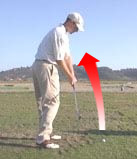How to Cure a Hook Golf Tip You'll often hear from veteran golfers and professionals that a golf slice is easier to "cure" than a hook. I definitely disagree and believe that the reasons for a slice and hook are very similar, just opposite. A slice occurs when the club face is open at impact, and is often accentuated by an out-to-in swing. The result is literally a "slicing" through the ball. The more of an out-to-in swing, the more the ball trajectory first starts out on the inside of your body and then spins and fades away. The hook is the exact opposite. The club face is closed at impact, and is often coupled with an in-to-out swing, causing the ball to first travel away from your body, and then hook back around. First let's concentrate on the club face at impact. Most hooks whether subtle or severe are caused by a closed club face. The reason is most likely due to premature wrist rotation. Your bottom thumb turns over too soon often before the club face makes contact with the ball/ground. This may be just due to turning your wrists over too soon, not following through with your hands to the target, or, in more severe cases, opening up your hips too soon. The first step to curing a hook is to make sure your hands and wrists are in the correct position at impact with ball/ground. You absolutely must be sure your wrists are not turning over too soon. You can practice this by chipping. Use a high iron, try a 7 or 8 iron. Start by taking your normal chipping swing/motion. If your ball is hooking, you're most likely turning your writsts over. Practice with this same club until your chipping swing motion results in a straight trajectory. Now it is time to concentrate on your body and weight shift. Using the same club, try a full swing. Still hooking the ball? The likely culprit is that your hands are leading your swing instead of your hips and legs. Your hands are coming through on your downswing too soon, instead of letting your hips and legs lead the way. The best drill to correct this problem is to take a very slow back swing, exaggerate as much as needed, even come to a complete stop at the top of your backswing. This will make sure that on your downsing your hips and legs lead your arms. It is kind of like a chain reaction; your legs and hips start on the downswing, and naturally your hands and arms follow. Practice the slow backswing repeatedly. Start off with a half swing at first, and absolutely make sure that your wrists are kept straight, that they do not turn over before striking the ball/ground, and that your hands follow through to the target instead of around your body (like a baseball swing). With enough practice you will begin to feel the difference between your "hook swing" and a swing that results in a slight draw or better yet a straight trajectory. Technorati Tags: golf golf hook golf tips golf hook cure |

|
|
